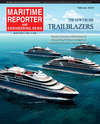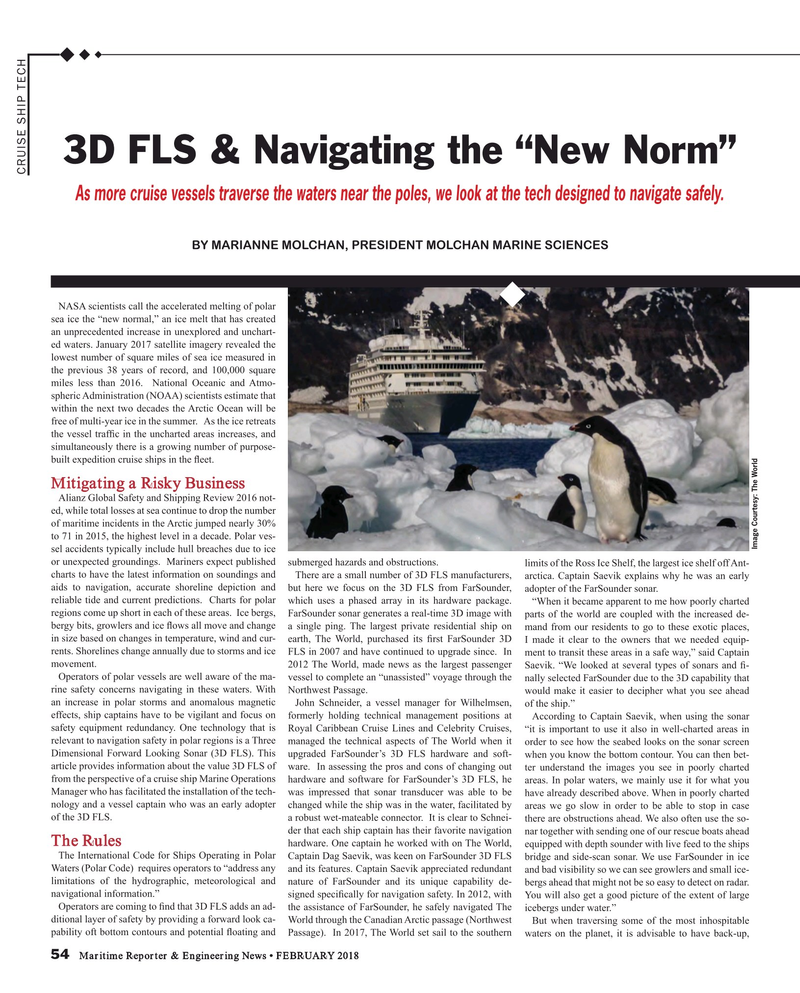
Page 54: of Maritime Reporter Magazine (February 2018)
Cruise Ship Annual
Read this page in Pdf, Flash or Html5 edition of February 2018 Maritime Reporter Magazine
3D FLS & Navigating the “New Norm”
CRUISE SHIP TECH
As more cruise vessels traverse the waters near the poles, we look at the tech designed to navigate safely.
BY MARIANNE MOLCHAN, PRESIDENT MOLCHAN MARINE SCIENCES
NASA scientists call the accelerated melting of polar sea ice the “new normal,” an ice melt that has created an unprecedented increase in unexplored and unchart- ed waters. January 2017 satellite imagery revealed the lowest number of square miles of sea ice measured in the previous 38 years of record, and 100,000 square miles less than 2016. National Oceanic and Atmo- spheric Administration (NOAA) scientists estimate that within the next two decades the Arctic Ocean will be free of multi-year ice in the summer. As the ice retreats the vessel traf? c in the uncharted areas increases, and simultaneously there is a growing number of purpose- built expedition cruise ships in the ? eet.
Mitigating a Risky Business
Alianz Global Safety and Shipping Review 2016 not- ed, while total losses at sea continue to drop the number of maritime incidents in the Arctic jumped nearly 30% to 71 in 2015, the highest level in a decade. Polar ves-
Image Courtesy: The World sel accidents typically include hull breaches due to ice or unexpected groundings. Mariners expect published submerged hazards and obstructions. limits of the Ross Ice Shelf, the largest ice shelf off Ant- charts to have the latest information on soundings and
There are a small number of 3D FLS manufacturers, arctica. Captain Saevik explains why he was an early aids to navigation, accurate shoreline depiction and but here we focus on the 3D FLS from FarSounder, adopter of the FarSounder sonar.
reliable tide and current predictions. Charts for polar which uses a phased array in its hardware package. “When it became apparent to me how poorly charted regions come up short in each of these areas. Ice bergs, FarSounder sonar generates a real-time 3D image with parts of the world are coupled with the increased de- bergy bits, growlers and ice ? ows all move and change a single ping. The largest private residential ship on mand from our residents to go to these exotic places, in size based on changes in temperature, wind and cur- earth, The World, purchased its ? rst FarSounder 3D I made it clear to the owners that we needed equip- rents. Shorelines change annually due to storms and ice FLS in 2007 and have continued to upgrade since. In ment to transit these areas in a safe way,” said Captain movement. 2012 The World, made news as the largest passenger Saevik. “We looked at several types of sonars and ? -
Operators of polar vessels are well aware of the ma- vessel to complete an “unassisted” voyage through the nally selected FarSounder due to the 3D capability that rine safety concerns navigating in these waters. With Northwest Passage. would make it easier to decipher what you see ahead an increase in polar storms and anomalous magnetic
John Schneider, a vessel manager for Wilhelmsen, of the ship.” effects, ship captains have to be vigilant and focus on formerly holding technical management positions at According to Captain Saevik, when using the sonar safety equipment redundancy. One technology that is Royal Caribbean Cruise Lines and Celebrity Cruises, “it is important to use it also in well-charted areas in relevant to navigation safety in polar regions is a Three managed the technical aspects of The World when it order to see how the seabed looks on the sonar screen
Dimensional Forward Looking Sonar (3D FLS). This upgraded FarSounder’s 3D FLS hardware and soft- when you know the bottom contour. You can then bet- article provides information about the value 3D FLS of ware. In assessing the pros and cons of changing out ter understand the images you see in poorly charted from the perspective of a cruise ship Marine Operations hardware and software for FarSounder’s 3D FLS, he areas. In polar waters, we mainly use it for what you
Manager who has facilitated the installation of the tech- was impressed that sonar transducer was able to be have already described above. When in poorly charted nology and a vessel captain who was an early adopter changed while the ship was in the water, facilitated by areas we go slow in order to be able to stop in case of the 3D FLS. a robust wet-mateable connector. It is clear to Schnei- there are obstructions ahead. We also often use the so- der that each ship captain has their favorite navigation nar together with sending one of our rescue boats ahead
The Rules hardware. One captain he worked with on The World, equipped with depth sounder with live feed to the ships
The International Code for Ships Operating in Polar Captain Dag Saevik, was keen on FarSounder 3D FLS bridge and side-scan sonar. We use FarSounder in ice
Waters (Polar Code) requires operators to “address any and its features. Captain Saevik appreciated redundant and bad visibility so we can see growlers and small ice- limitations of the hydrographic, meteorological and nature of FarSounder and its unique capability de- bergs ahead that might not be so easy to detect on radar. navigational information.” signed speci? cally for navigation safety. In 2012, with You will also get a good picture of the extent of large
Operators are coming to ? nd that 3D FLS adds an ad- the assistance of FarSounder, he safely navigated The icebergs under water.” ditional layer of safety by providing a forward look ca- World through the Canadian Arctic passage (Northwest But when traversing some of the most inhospitable pability oft bottom contours and potential ? oating and Passage). In 2017, The World set sail to the southern waters on the planet, it is advisable to have back-up, 54 Maritime Reporter & Engineering News • FEBRUARY 2018
MR #2 (50-57).indd 54 MR #2 (50-57).indd 54 2/8/2018 10:27:19 AM2/8/2018 10:27:19 AM

 53
53

 55
55
